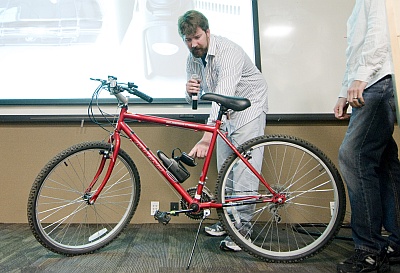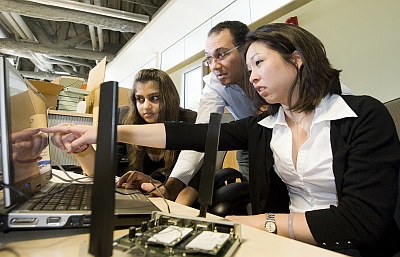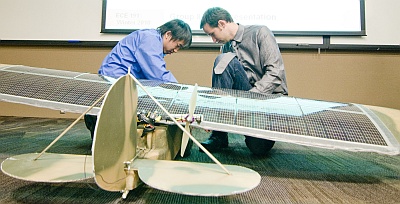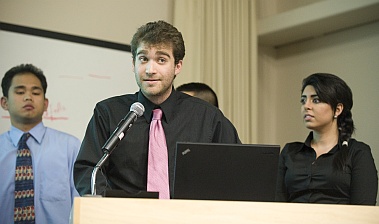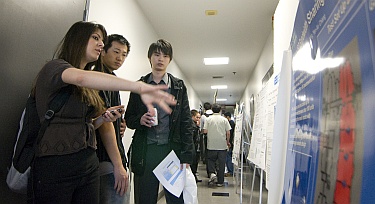Student Presentations Show Off Undergrad Team Engineering Design Skills
|
San Diego, CA, April 7, 2010 — For their final exam, more than 50 engineering undergraduates recently presented the culmination of their quarter's efforts on a group-design hands-on engineering project to a packed house of fellow students, mentors, family and friends.
The 56 students worked on 15 wide-ranging engineering projects for the Electrical and Computer Engineering (ECE) department's ECE 191 course.
"I enjoyed the presentations very much," said Paul Yu, associate vice chancellor for Research Initiatives. "Most of the students are able to describe in simple, yet technical, terms the goal of their project, and most importantly, their unique approach to solving the problem."
"I find that the ECE 191 project course is distinctly the dividing line along the path from the students learning through course work to a creative and collaborative experience," Yu explained.
|
ECE 191, Engineering Group Design Project, is an upper-division class that provides undergraduates with hands-on experience working in a team to design, build, demonstrate and document an open-ended engineering project. It is part of the design requirement for ECE undergraduates and is typically taken by seniors. Long-time instructor, Pankaj K. Das, was joined Winter quarter by co-instructor Mohan Trivedi; both are professors in the ECE department.
"ECE 191 is hands-on experience, and being able to apply everything that we've been learning for the last four years," said Victoria Wong, "and making it tangible is so liberating as a senior." Wong will be graduating in June and will begin working at Cisco in September.
ECE 191 projects are funded and mentored by campus organizations and by corporate affiliates of the Jacobs School of Engineering. Calit2 is a long-time sponsor, with two projects this quarter.
|
Osama Ibrahim, Tejal Vora, and Victoria Wong worked with Calit2 researchers B. S. Manoj and Bheemarjuna Reddy Tamma on a project involving cognitive networking, "TCP over Cognitive Wireless LANs." As is true of many ECE 191 projects, they leveraged the work of past teams and built a foundation for the next project. Manoj and Tamma, mentoring progressive ECE 191 project groups and others, have developed a prototype autonomous cognitive access point (CogAP) which learns the network traffic patterns in the environment in order to predict the traffic, so that it can dynamically reconfigure the users or clients to the optimal channel.
"We are building on the neural network-based design and have implemented three prediction schemes," explained Tejal Vora. "We have also made a control channel for our device, to let the user know beforehand which channel it will switch to, which will reduce switching time and speed up the reconfiguration of the channel." Wong added: "Being able to successfully reduce the time is a big deal for cognitive access points because the one drawback of switching channels is that the client is lost while it blindly cycles, trying to find the new channel. During this time, no data is sent."
|
Bill Hodgkiss, Calit2's associate director, mentored Rod Alvin Baltazar, Jeremy Bonner, Tara Dowlat, and Donovan Lo on "Software Defined Radio." They used GNU Radio and the Universal Software Radio Peripheral (USRP) to build a software-defined radio using frequency modulation. Hodgkiss a professor at Scripps Institution of Oceanography and adjunct professor in ECE.
In addition to Calit2, the Computer Vision and Robotics Research (CVRR) Lab and industry participants MagCanica and Utech also sponsored two groups each. Other sponsors this quarter included Ideal Industries, Inc., Mushroom Networks, Raytheon, and SPAWAR. ViaSat sponsored three projects, including one of three award winners.
Yu is a professor in ECE and served as the preliminary judge of the presentations. In this role, he chose three projects. Das and his co-instructor usually pick a single project from the three for the best project award (based not only on the presentation and poster session, but also the cumulative efforts over the quarter). However, this quarter, they agreed that all three were excellent, that there was no single, "best" one. Das and Trivedi commented on the widespread excellence of the projects (even beyond the top three) when they awarded the following projects as the top three.
Azin Alavi, Kyle Bales, Tim Stockwell, Chris Toro worked with Chuck Pateros and Brad Exmeyer from ViaSat on a "High Intensity Bike Light." They built, tested and packaged a working bicycle light, costing under $100 dollars. Tests showed that their light's high function is brighter than a comparable $70 ‘off the shelf´ light and they improved the strobe rate as well. The package is ready to be used in the Race Across America in June (in which several ViaSat employees will be participating).
|
Brendan Morris of the CVRR Lab mentored Jonathan Clark, Christopher Doran, and Ryland Fallon for the "Visual Traffic Analysis" project. They successfully created software that can connect with a remote camera and detect flow patterns of traffic in its field of view. This data is useful for urban planning, identifying real-time safety problems, and traffic routing.
The third winning project was sponsored by Ideal Industries INC., mentored by Norm Dawson and David Fern. David Dao, Anthony Elbancol, and Kurt Hale worked on a "Compact Inertial Navigation System." Using basic kinematics equations, they created a portable device that can plot and track the position of the user. The unit is self contained and remote from any computer connection or peripherals, making is useful for practical applications.
A new group of students is just beginning their Spring Quarter projects under the guidance of their mentors, with Das and Charles Tu as their instructors. In addition to being an ECE professor, Tu is the associate dean of UCSD's Jacobs School of Engineering.
Related Links

